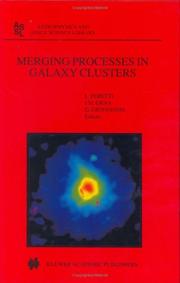| Listing 1 - 3 of 3 |
Sort by
|
Book
ISBN: 1634821084 9781634821087 9781634821070 1634821076 Year: 2015 Publisher: New York : Nova Publishers,
Abstract | Keywords | Export | Availability | Bookmark
 Loading...
Loading...Choose an application
- Reference Manager
- EndNote
- RefWorks (Direct export to RefWorks)
This book presents a comprehensive review of the methods applied to derive cosmological parameters for a given model and test different cosmological models using the most massive collapsed structures in our Universe: clusters of galaxies. Clusters typically consist of hundreds of galaxies and high-temperature ionized gas trapped in their gravitational field dominated by dark matter extending out to 2-3 Mpc. The formation, evolution, and structure of these massive rare objects are sensitive probes of the assumed cosmology. This is a multidisciplinary field of astrophysics involving multi-wavele
Galaxies --- Cosmology. --- Astronomy. --- Astronomy --- Deism --- Metaphysics --- Clusters of galaxies --- Galaxy clusters --- Groups of galaxies --- Clusters. --- Groups
Book
ISBN: 1281397830 9786611397838 0387788751 0387788743 1441927026 Year: 2008 Publisher: New York : Springer,
Abstract | Keywords | Export | Availability | Bookmark
 Loading...
Loading...Choose an application
- Reference Manager
- EndNote
- RefWorks (Direct export to RefWorks)
Clusters of galaxies are the largest structures in the Universe. Most of the visible matter is in the form of hot gas permeating the volume of the cluster. The bulk of this gas is in thermal equilibrium in the dark matter-dominated potential. This book discusses all aspects of cluster physics beyond this thermal view. It covers topics such as the warm-hot intergalactic medium outside the clusters, non-thermal radiation components, shocks, equilibration processes and the chemical evolution of these structures. The topics are covered from an observational, theoretical and numerical point of view. This volume provides a useful reference for astronomers and graduate students, in particular for those who are working in high-energy astrophysics and extra-galactic astronomy.
Galaxies --- Thermogravimetry. --- Clusters. --- Thermal gravimetric analysis --- Gravimetric analysis --- Thermal analysis --- Clusters of galaxies --- Galaxy clusters --- Groups of galaxies --- Groups --- Astrophysics. --- Astrophysics and Astroparticles. --- Space Sciences (including Extraterrestrial Physics, Space Exploration and Astronautics). --- Astronomical physics --- Astronomy --- Cosmic physics --- Physics --- Space sciences. --- Science and space --- Space research --- Cosmology --- Science

ISBN: 0306480964 1402005318 Year: 2002 Publisher: Dordrecht ; Boston : Kluwer Academic Publishers,
Abstract | Keywords | Export | Availability | Bookmark
 Loading...
Loading...Choose an application
- Reference Manager
- EndNote
- RefWorks (Direct export to RefWorks)
Mergers are the mechanisms by which galaxy clusters are assembled through the hierarchical growth of smaller clusters and groups. Major cluster mergers are the most energetic events in the Universe since the Big Bang. Many of the observed properties of clusters depend on the physics of the merging process. These include substructure, shock, intra cluster plasma temperature and entropy structure, mixing of heavy elements within the intra cluster medium, acceleration of high-energy particles, formation of radio halos and the effects on the galaxy radio emission. This book reviews our current understanding of cluster merging from an observational and theoretical perspective, and is appropriate for both graduate students and researchers in the field.
Physics. --- Gravitation. --- Observations, Astronomical. --- Astronomy --- Astronomy, Observations and Techniques. --- Classical and Quantum Gravitation, Relativity Theory. --- Observations. --- Astronomical observations --- Observations, Astronomical --- Field theory (Physics) --- Matter --- Physics --- Antigravity --- Centrifugal force --- Relativity (Physics) --- Natural philosophy --- Philosophy, Natural --- Physical sciences --- Dynamics --- Properties --- Astronomy—Observations. --- Galaxies --- Clusters. --- Clusters of galaxies --- Galaxy clusters --- Groups of galaxies --- Groups
| Listing 1 - 3 of 3 |
Sort by
|

 Search
Search Feedback
Feedback About UniCat
About UniCat  Help
Help News
News